Potholing, also known as daylighting, is the procedure for safely exposing underground utility lines to get a visual confirmation of their infrastructure.
This process takes on many forms, but the most common is the potholing vacuum excavation method. Small holes around the depth of 6 to 12 feet are dug into the ground to assess the approximate location of utility lines.
These pipes include sewerage lines, electricity lines, water pipes, and gas lines. Utility service lines fall into two categories; public and private utilities. Both are exceptionally important in the day-to-day activities of the surrounding neighborhoods and businesses. Damage to these lines could cause service interruptions, hefty fines, and in worst-case scenarios, accidents.
Gas lines can explode when damaged during an excavation project, while water lines can create sinkholes. This will not only disrupt the project but also pose safety hazards to those on site. Before embarking on an underground excavation project, hiring a private utility location company like Util-Locate is imperative to ensure your successful excavation project.
Let’s dive in at the five necessary steps in pre-excavation potholing.
1. Finding a Qualified Underground Utility Locator
The first and most important step is to hire a professional and qualified underground utility location service like Util-Locate. Partnering with the right team is imperative to ensure the task is handled efficiently and accurately.
A knowledgeable team of utility locators will be able to tell the exact location of utility lines and the soil conditions and excavation depth that may affect your project. Util-Locate is an industry leader with state-of-the-art location and detection technology.
2. Scanning and Detecting Underground Utilities
Once the utility detector has arrived at the site, they will scan the entire area. A scanner is used to locate utilities up to a depth of 13 feet. This scanner has a 97% accuracy and verifies the actual position of all utility pipes and lines. Once the entire area has been checked, zones with utility lines running underneath will be marked.
3. Understanding the Marked Zones
The next step to follow is to analyze all the marks made. Understanding their placement and how it affects the excavation is critical to avoid accidentally damaging utility lines. This will also dictate the depth of excavation.
4. Establishing Adequate Safety Precautions
When the dig has been adjusted to suit the layout of the land, the risks and dangers of hitting the utility pipe should be assessed. Understanding the purpose of the utility line and what could happen in case of an accident is a necessary step. Mistakes happen constantly, but ensuring the correct safety measures are implemented can help you prepare for every outcome.
5. Setting Up Location Marks
An additional step that could be taken at the excavation site is to set up clean indicators for the team to avoid. When working on an excavation project, it can be easy to get carried away and forget where certain things may be. As an added layer of safety, mark the locations where excavation should be avoided.
What are the Possible Dangers of Digging Without Utility Location Mapping?
Getting an inaccurate mapping of underground utility lines can result in physical and financial damages. Since these lines all serve a specific function, damaging one or many could put the worker’s life in danger, as well as cause service interruptions.
Gas lines are one of the most dangerous lines to damage as they are exceptionally sensitive. A simple spark can cause the line to explode and damage the surrounding area and property.
Water lines can cause water damage to the surrounding areas and properties, form sinkholes, and disrupt the integrity of the adjacent structures in the excavation site. Avoiding these common utility lines is imperative in ensuring the safety and well-being of all people involved.
Hire a Professional Team of Underground Utility Locators
Hiring an underground utility location service is an important step before an excavation project because it allows the team to navigate through the site without any risk of damaging lines. As an industry expert, Util-Locate specializes in accurately locating and identifying utility lines while providing the necessary information to excavate safely.
To learn more about our potholing excavation and utility mapping services, contact Util-Locate today!

